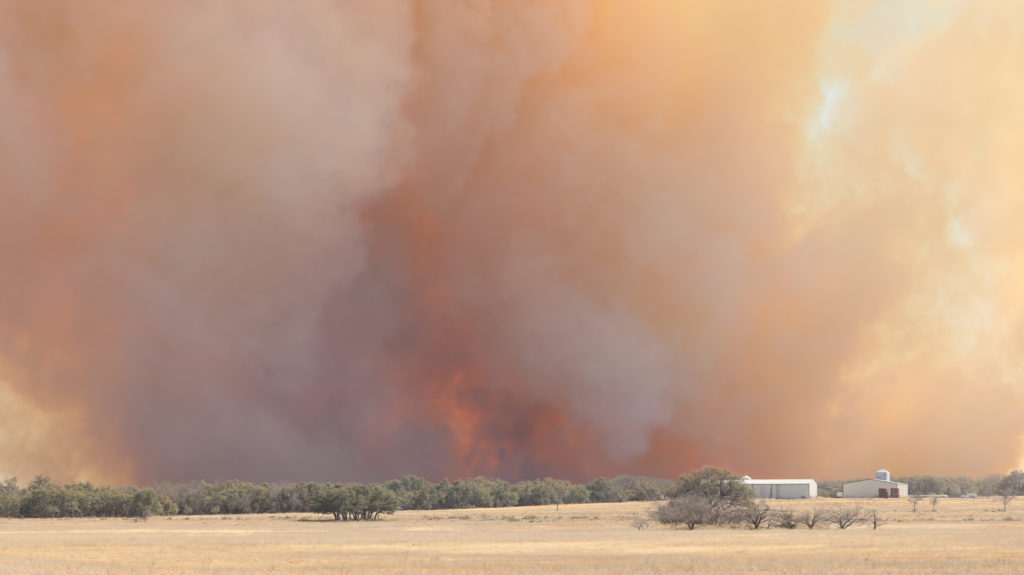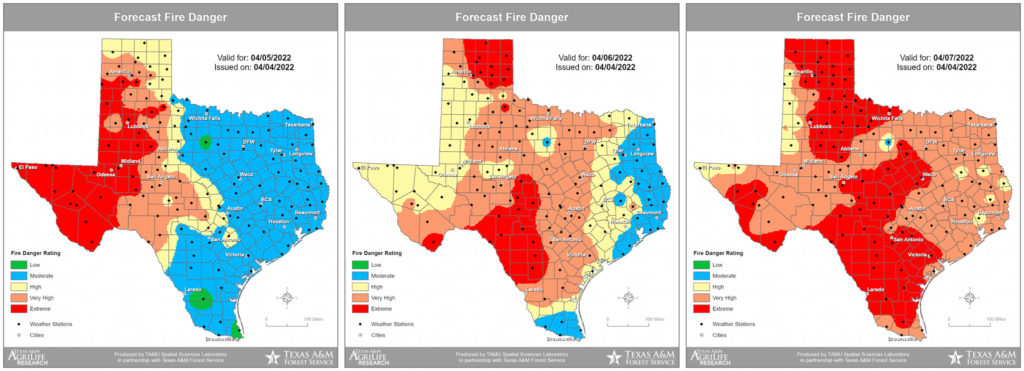
Wildfire activity is expected to gradually increase throughout the week, as periodic critical fire weather occurs where very dry vegetation is present across West and South Texas.
On Tuesday, critical fire weather and above normal temperatures will support the potential for large wildfires that are resistant to firefighters’ suppression efforts near Amarillo, Lubbock, Childress, Sweetwater, San Angelo and Ozona where grasses are critically dry.
Large wildfires are likely on Wednesday in South Texas where critically dry to extremely dry fuel will be exposed to above normal temperatures and critical fire weather. Critically dry vegetation in the Eastern and Western Hill Country may also support wildfire ignitions on Wednesday.
A prolonged period of accelerated drying Wednesday through Sunday will expand the area of dry to extremely dry vegetation across the landscape and will continue to support wildfire activity through the weekend.
Texas A&M Forest Service continues to monitor the situation closely and has positioned personnel and equipment across the areas of concern for a quick and effective response to any new wildfire ignitions.
In addition to the more than 300 firefighters from Texas A&M Forest Service, more than 170 Texas Intrastate Fire Mutual Aid System (TIFMAS) firefighters as well as personnel from 28 states have been mobilized to assist with response efforts.
Thirty-three aircraft, including three large airtankers, 15 single engine air tankers, seven type 1 and type 3 helicopters, are also staged across the state for wildfire response.
Since January 1, 2022, Texas A&M Forest Service and local fire departments have responded to 3,018 wildfires that burned 403,711 acres. This total includes 978 wildfires in the month of March that burned 348,403 acres.
“The agency is dedicated to protecting the citizens and natural resources of this state from wildfire,” said Wes Moorehead, Texas A&M Forest Service Fire Chief. “It is crucial, however, that residents take action around their home to reduce wildfire risk.”
Successfully preparing for a wildfire requires everyone to take personal responsibility for protecting themselves, their families and their properties.
“It is the responsibility of each individual resident to prepare their home for wildfires,” said Kari Hines, Texas A&M Forest Service Firewise Program Coordinator. “Every year, hundreds of homes survive wildfires unaided, allowing firefighters to operate safely to protect them, due to the landscaping and building choices made long before the fire ever started.”
Creating defensible space around your home allows for low intensity, slow-burning conditions in the event of a wildfire. Texas A&M Forest Service encourages Texans to take the following steps around their homes today to reduce the risk of wildfire:
-
Within the first 30 feet of your home, use non-flammable landscaping materials. Within the first five feet, water plants, trees and mulch regularly, and consider xeriscaping if you are affected by water restrictions.
-
A healthy, well-maintained landscape is important to the survival of homes during a wildfire. Make sure your plants are carefully spaced, low growing and free of resins, oils and waxes that burn easily.
-
Remove dead vegetation from under the deck of your home and within 10 feet of the house.
-
Prune your trees so that low-hanging branches do not touch the ground.
“Even simple things such as moving flammable material away from wooden structures like decks and steps, pruning shrubs in front of windows and under mature trees and cleaning out gutters can be done with a limited amount of time if a wildfire is in the area,” said Hines.
Stay wildfire aware. If a wildfire is spotted, immediately contact local authorities. A quick response can help save lives and property.
For current conditions and wildfire outlook, read the Texas Fire Potential Outlook https://bit.ly/3kemhbG.
Texas A&M Forest Service does not own any aviation resources but instead uses federal aviation contracts through the U.S. Forest Service and Bureau of Land Management for all firefighting aircraft.
